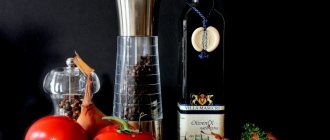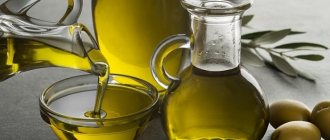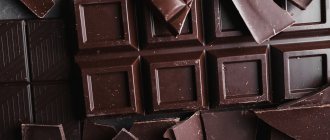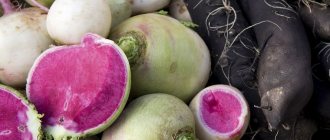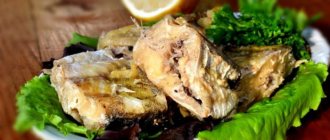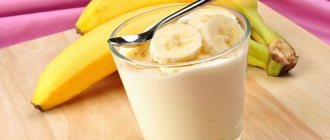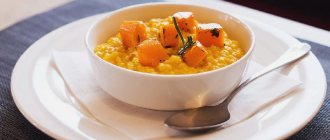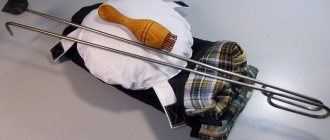Almost everyone eats pollock, but some don't realize it. It does not belong to valuable fish species, but is important in the food industry. This amazing fish is on the menu of expensive restaurants and fast food chains. And its chopped fillet is used as a raw material for the production of cheaper seafood analogues. In terms of nutritional value, pollock, like salmon, tuna and cod, is a good source of lean protein, selenium, phosphorus and vitamin B12.
Biological characteristics
Content:
- Biological characteristics
- The nutritional value
- Beneficial features
- Important Components
- Who needs pollock
- How to choose the right pollock
- Why is this fish dangerous?
- What to cook from pollock
- Surimi at home
Pollock is one of the most important bottom fish for the industry. In the fishery it ranks second after the Peruvian anchovy. Belongs to the cod family, like other representatives of this genus, has 3 dorsal fins and mustache. You can recognize this inhabitant of the seas by its olive-green belly and splashes on its body, large eyes and protruding lower jaw. An adult fish can reach 30-90 cm and weigh from half a kilogram to 800 g. It thrives both in shallow water and at depths of up to 200 m, although during the day it usually moves between the seabed and the surface of the water. Natural habitat is the cold waters of the North Pacific Ocean. Large catches of this fish can be expected along the western coast of America and the eastern coast of Asia. During the spawning period, when schools of fish swim close to the shore, it is easy to catch even with a fishing rod. It is important that if it is caught in the bays of Alaska, near the Aleutian Islands, or in the waters of the Bering Sea, you do not have to worry about the fish being contaminated with mercury or other chemicals. By origin, pollock can be Russian or from Alaskan waters. Russia's fishing industry is concentrated in the Sea of Okhotsk and Bering Sea.
This relatively fast-growing fish feeds on crustaceans, krill and other small sea creatures. The average life expectancy is up to 17 years, but fishermen value 3-4-year-old carcasses most of all. During the mating season, female pollock are especially interesting for their eggs. But despite this, pollock is not an endangered species. And the main reason is that it reproduces very quickly. In a few days, female pollock lay hundreds of thousands of eggs, from which from 100 thousand to a million offspring are born after 9-28 days.
In the period before spawning, the meat of this fish is valued, from which, in addition to fillets, they make fish sticks and surimi - an imitation of crab meat.
How to cook pp pollock in the oven
The simplest and fastest recipe, but also the most delicious. You will need these ingredients:
- 1 fish fillet. It is very important that it is dry. Take the time to dry it thoroughly with paper towels.
- 15 grams of butter. Many people are afraid to use this oil while dieting. But do not forget that it contains animal fats, which are also necessary for our body. Do not forget that even during a diet, the amount of fat consumed should not be less than 30-40 grams per day! In addition, this oil contains a lot of useful vitamins!
- spices to taste. You can use Italian or Provençal herbs.
- Salt and black pepper
We will bake it in foil. Place the fish on it, sprinkle with spices and add pieces of butter. Wrap it in the oven for 30-40 minutes. Temperature 180 degrees.
Interesting! According to the World Health Organization, the number of people diagnosed with obesity is rapidly increasing worldwide. For example, in 2021, about 1.9 billion people were overweight, which could lead to serious illnesses. Of this number, 650 million were diagnosed as obese. Nutritionists attribute this to high consumption of high-carbohydrate foods and low consumption of protein foods.
The nutritional value
The flaky texture and subtle aroma make pollock an exceptional product. Although, for the sake of fairness, it is worth noting that this fish does not belong to varieties with a pronounced taste. And this is one of the reasons why pollock is not extremely popular. However, among the main advantages is the fact that this fish contains virtually no mercury, which makes it a safe alternative to many other seafood products. In addition, pollock is an important source of amino acids, chemicals necessary for the construction of protein blocks.
It is impossible to talk about the beneficial properties of pollock without recalling the vitamins contained in this fish. And it is rich in B vitamins (B1, B2, B6, B9), antioxidant vitamins A and E, and also contains ascorbic acid. Minerals are represented by a complex of zinc, iron, chromium, copper, iodine, nickel, manganese, molybdenum, fluorine and cobalt.
A 100-gram serving of pollock will provide the body with Omega-3 fatty acids in a serving of 400-500 mg.
In addition, it contains enough Omega-6 fats. The nutritional composition of pollock largely depends on the method of preparing the fish. For example, a breaded, fried product will be higher in calories and contain a lot of carbohydrates and saturated fat. Surimi has little protein and fat, but quite a lot of carbohydrates. But absolutely all pollock products contain Omega-3, although in different concentrations. Table of content of useful components in 100 g of raw product
| Calorie content | 72 kcal |
| Squirrels | 17 g |
| Fats | 1 g |
| Carbohydrates | 0.1 g |
| Water | 80 g |
| Cholesterol | 50 g |
| Ash | 1.3 g |
| Vitamin A | 0.01 mg |
| Vitamin B1 | 0.12 mg |
| Vitamin B2 | 0.11 mg |
| Vitamin B3 | 4.5 mg |
| Vitamin B6 | 0.2 mg |
| Vitamin B9 | 0.05 mg |
| Vitamin C | 0.6 mg |
| Vitamin E | 0.4 mg |
| Calcium | 41 mg |
| Sodium | 41 mg |
| Magnesium | 56 mg |
| Phosphorus | 245 mg |
| Potassium | 418 mg |
| Iodine | 0.2 mg |
| Fluorine | 0.8 mg |
| Copper | 0.2 mg |
| Sulfur | 174 mg |
| Zinc | 1.1 mg |
| Iron | 0.9 mg |
| Chlorine | 164 mg |
Delicious dietary dishes
Experts say that it is best to cook pollock using the simplest, most accessible methods, which will only emphasize its pleasant taste and will not add calories.
The taste of the fish is a little dry, so most often housewives prefer to bake it in the oven or stew it with vegetables.
Baked pollock in spicy sauce
For example, for baked pollock in spicy sauce you will need:
- fish fillet - 700 g;
- walnuts - 100 g;
- pickled cucumbers - 2 pcs. (small);
- sour cream - 4 tbsp. l.;
- salt, pepper, fresh herbs - to taste;
- butter - 10 g.
This preparation:
- The fish must be processed, all bones removed, and the fillets cut into medium-sized pieces. The pollock prepared in this way is salted and peppered, then fried in a frying pan in a small amount of oil until golden brown.
- At the same time, the sauce is being prepared. To do this, walnuts, herbs, cucumbers, sour cream and spices are thoroughly ground in a blender.
- The fried fish is laid out on a baking sheet greased with butter and sauce is poured on top.
- The oven should be preheated to 200 degrees. Bake for 25 minutes.
Pollock with vegetables in egg batter
You can also bake pollock with vegetables in egg batter.
- To do this, you need to cut 600-700 grams of fillet into pieces and sprinkle with two tablespoons of lemon juice.
- Then place them in a greased pan.
- On top are three tomatoes cut into circles, sprinkle everything with parsley, salt and pepper. Pour in two beaten chicken eggs.
- Bake for 20-25 minutes in an oven preheated to 200 degrees.
Pollock baked with carrots and onions
For fish baked with carrots and onions, you need:
- pollock - 1 pc. (medium size);
- onion - 1 pc.;
- carrots - 1 pc.;
- sour cream - 50 g;
- salt and pepper - to taste.
Cut the fully processed fish into medium-sized pieces, add salt and pepper. Cut one onion into ring halves, grate the carrots on a coarse grater and place them in layers in a greased form. We put pollock on them.
Pour sour cream and 3-4 tablespoons of boiling water over the fish. Cover the baking dish with foil and place in an oven preheated to 200 degrees for 25-30 minutes.
Beneficial features
Pollock is not a fatty fish. This product is useful for obese people, as well as people who, for other reasons, are contraindicated to consume fat.
In addition, fish contains cobalt, which regulates lipid and carbohydrate metabolism. On the other hand, pollock, thanks to its rich mineral and vitamin composition, is useful for maintaining general health, as well as for restoring the body after illness.
This type of fish is recommended to be included in the diet of smokers, who, as a rule, experience problems with their gums and teeth. Ascorbic acid, fluoride and other components contained in fillets help strengthen gums. This product is also useful for people who care about their hair, nails and skin. It is necessary to activate the production of enzymes, as well as restore the correct chemical composition of the blood.
Nutritionists advise children, especially during periods of intensive growth, and older people to consume this fish. By the way, this is one of the few products that is hypoallergenic; many introduce it into complementary foods for children from 8 months. Nutritionists note the benefits of this fish for pregnant women and women during lactation. It is important to regularly include this sea creature in your menu for people with thyroid disorders or those living in regions with iodine deficiency. By the way, a 100-gram serving of pollock contains the full daily requirement of this element
Recommendations for eating fish
Pollock is best eaten boiled, stewed or baked. It cooks very quickly . Before cooking, you need to cut off the head, fins and tail from a whole carcass, carefully remove the entrails, trying not to damage the gall bladder, and cut into portions. It is usually sold as fillets or gutted carcasses without heads.
Then soak in salted water (10 g/1 liter of water) for one hour to remove possible heavy metal salts.
Nutritionists recommend eating it at breakfast in combination with a vegetable salad . Such food will provide energy for the whole day without leaving a feeling of heaviness in the stomach.
If you don’t want to have a big breakfast, you can also eat this fish at lunch, combining it with boiled vegetables and fresh salad. You should not eat pollock at night.
Animal protein is poorly absorbed during sleep.
Healthy people can eat 200-250 g per day, three times a week. The same amount can be recommended for pregnant and lactating women in the absence of contraindications.
Elderly people with diabetes should limit consumption to 150 g per day, twice a week.
Children under three years old can eat fish once every 7 days in the amount recommended by the pediatrician. After three years, pollock can be included in the diet of children twice a week, 50-150 g, depending on age.
Important Components
Proteins and amino acids
Pollock is a rich source of protein and provides the body with a sufficient amount of amino acids. The human body needs these elements to build cells and tissues, they support the immune system, and some of them are essential for brain function. Pollock is a product containing the so-called “complete” protein, which contains all the essential amino acids for humans. 150-200 g of fish contains approximately 20 g of proteins.
Choline and vitamin B12
Pollock dishes are a good source of choline and vitamin B12. They are necessary to maintain a healthy nervous system and proper brain function. In particular, choline is important for the proper functioning of brain cells, and vitamin B12 produces a protective substance for nerve cells called myelin. In addition, choline is necessary for the maintenance of cell membranes, and vitamin B12 is necessary for the production of red blood cells.
Phosphorus and selenium
To replenish phosphorus and selenium in the body, it is necessary to introduce sea fish, such as pollock, into the diet. Phosphorus is an essential component of bone tissue. It is also necessary for the formation of cell membranes and DNA. Selenium supports the healthy functioning of blood vessels and regulates the functioning of the thyroid gland, preventing the formation of cancer tumors.
Ideal fish for losing weight
It is difficult to overestimate the benefits of pollock for human health, since out of the entire vast fish family it is literally a storehouse of vitamins and microelements. Doctors recommend eating this fish for pregnant women and babies aged eight months and older.
Pollock is rich in vitamins of groups A, PP, B1, B2, B9, C, contains calcium, magnesium, phosphorus, sulfur, iron, potassium, cobalt, iodine, fluorine, sodium.
It should be noted that almost the entire amount of vitamin A is concentrated in the liver of fish. So if you have a need for vitamins of this particular group, it is better to specifically buy canned goods with this product.
Due to its unique composition, pollock liver is widely used even in cosmetology - in particular, in the production of anti-aging drugs.
What else will pollock please our body with?
- The iodine contained in fish is considered an excellent remedy for the prevention of thyroid diseases.
- Elements such as calcium, phosphorus and fluoride are responsible for ensuring that a person has strong teeth and a skeletal system.
- Vitamin C helps strengthen the immune system and improves tone.
- Potassium and sodium ensure the prevention of cardiovascular diseases, and cobalt promotes the absorption of iron and normalizes the condition of the circulatory system.
- If pollock is eaten regularly at least twice a week, this will ensure constant maintenance of normal blood sugar levels.
- Also, fish, mainly in its liver, contains Omega-3 and Omega-6 fatty acids. These valuable substances are responsible for stimulating brain function and stabilizing blood pressure, and also eliminate excess cholesterol.
Due to its extremely low calorie content, fish is perfect for people on diets. The fat content of the fillet is no more than 1 percent. At the same time, it contains practically no carbohydrates, but the protein content is extremely high!
Easily digestible proteins account for 16 percent of the total weight of fish. Thanks to this, pollock is respected by athletes who need large quantities of protein for serious physical activity.
Pollock can be harmful, but it affects a fairly narrow group of people. Fish protein often causes a reaction in allergy sufferers, so any type of fish is prohibited for them. Caviar containing a large amount of salt is also harmful. It is better to refrain from using it for people suffering from hypertension and peptic ulcers.
It is very important to carefully inspect the purchased carcass for parasites and rinse it well under running water. You need to examine the gills especially carefully, and it is better to immediately buy gutted fish without a head.
Who needs pollock
Considering the chemical composition and beneficial properties of this fish, we can say that for some diseases and conditions of the body, pollock serves as a therapeutic and prophylactic product.
It is important to take care of the presence of this fish in the diet when diagnosed:
high cholesterol;- instability of blood pressure (especially jumps in the direction of a sharp decrease);
- atherosclerosis or the risk of this disease;
- chronic weakness and fatigue;
- thyroid dysfunction;
- disruption of the digestive organs.
In addition, pollock is useful for:
- increased mental work;
- slagging of the body;
- general weakness after illness;
- increased stress on the heart.
Interesting facts about pollock
Having talked about the beneficial properties of pollock, we can move on to something interesting...
Pollock is a long-lived fish. The luckiest fish of this species live up to 20 years - this is the maximum age for which scientists have noted. True, most individuals still do not reach this record, since they are very actively caught. At the same time, as a rule, on the shelves of our stores, pollock is presented mainly as cut carcasses and fillets, so you can see this fish in its natural form only at fishing markets and on advertising brochures (which is much more important for us).
Fish casserole with potatoes and pollock fillet: see recipe
How to choose the right pollock
Pollock, as is already clear, is a healthy fish, tasty and, most importantly, available for purchase. But in order for it to bring as much benefit to the body as possible, it is important to know how to choose the right pollock carcasses. Here are some tips on what is important to pay attention to.
Before looking closely at the fish, it is worth asking where it was caught. In our latitudes, pollock is caught only in Russia, China and Japan. Although it is almost impossible to find a Japanese product in our markets. If you are offered fish from other countries, you can be sure: it is definitely not pollock.
Next, it is important to study the color and smell of the product. The fillet should be pure white, without yellow or other colored spots. As for the smell, in old fish it is unpleasant and pungent, in fresh fish it is sweetish.
If you are going to buy frozen fillets, you need to carefully examine the ice crust on each piece. Ice on the fish should not be more than 4% of the total weight.
Pollock should be stored at a temperature of minus 18 degrees Celsius or lower.
Pollock in the oven
Pollock is one of the most accessible and inexpensive types of fish. For culinary experts, a positive feature of this popular fish is the almost complete absence of small bones, which makes preparing and eating fish dishes convenient and enjoyable. Beginning cooks need to know that this inhabitant of the sea turns out to be somewhat dry when cooked, since it is almost devoid of fat, so during the preparation of the culinary dish it is necessary to ensure that its juiciness is preserved. The most juicy and tender fish is cooked in the oven. Recipes for pollock in the oven should be in every housewife's notebook. You can bake the fish in foil, a sleeve or on an open baking sheet. It goes well with sour cream, cream, mayonnaise and all kinds of sauces. A perfect pairing will be vegetables such as potatoes, carrots, onions, tomatoes, bell peppers, as well as cheese, lemon and other ingredients that can be found in the refrigerator of any family. An unsurpassed, piquant dish is obtained by using a variety of herbs (dill, parsley, cilantro, basil) and spices. Cooking pollock is very simple, just follow the recipe. Even the most inexperienced housewife will be able to create a real masterpiece of culinary art.
Read the article How to cook deliciously in the oven using the wrong recipes . This will help you cook in any oven and always get dishes of perfect quality!
Why is this fish dangerous?
As already noted, the advantage of pollock over other marine fish is that it is less susceptible to mercury contamination than other marine inhabitants. But there are still several nuances that in some cases require using this product in limited quantities or abandoning it.
Although quite rare, allergies to pollock dishes do occur. This condition is usually caused by individual intolerance. Secondly, pollock, the absolute leader among fish in terms of protein content, will have to be abandoned by people with protein intolerance. This is also a fairly rare and serious disease. The third reason why it is important to limit the frequency of fish consumption is hypertension. And all because pollock contains a lot of salt in its meat.
If you are not sure whether your body can tolerate pollock, it is recommended to gradually include fish in your diet in small portions.
Pollock as an effective element of weight loss
Pollock is an ideal dietary product with low calorie content and a large selection of cooking methods that will not lose beneficial properties or increase calorie content.
To lose weight, it is better to steam fish, for example, in the form of cutlets, bake fillets in the oven, boil or stew without oil with vegetables or rice.
Due to the fact that fish consists of almost 100% proteins, which are absorbed by the body as quickly as possible, the functioning of the stomach and intestines improves, and metabolism accelerates. If you exercise at the same time, your muscle mass will increase, which will make your body more toned and strong.
To lose weight, you should not eat salted or fried pollock. In the first case, fluid will be retained in the body, which will lead to swelling and poor health, and in the second, the caloric content increases and all beneficial properties are completely destroyed.
Note: pollock liver, despite its high calorie content, can be eaten while losing weight, but in small portions.
What to cook from pollock
The meat of this representative of cod is white, soft, with a delicate flaky texture. Due to its high adaptability, it is consumed in various forms. Pollock fillet can be frozen, fried, baked, stewed, and used to make fish sticks, chips, and surimi. The Japanese salt, dry and dry this fish. It is also used to make imitation crabs, shrimp, scallops, feed meal, minced fish, and canned food.
Surimi is produced by grinding pollock fillets, to which other ingredients are added to stabilize the protein, which allows the product to be frozen for a long time without compromising quality. In addition, caviar and liver are used in the food industry. Vegetables are best suited as a side dish for fish dishes.
Harmful properties of pollock
Eating pollock can lead to the development of allergic reactions. Therefore, if you have an individual intolerance to fish or seafood, then pollock should be completely excluded from your diet. It should not be used frequently by those who suffer from kidney disease, arterial hypertension or peptic ulcers of the stomach and duodenum. This is due to the high content of sodium chloride (table salt) in pollock, which can provoke an exacerbation of the disease.
Video from YouTube on the topic of the article:
Recipe for steamed pollock. Calorie, chemical composition and nutritional value.
Steamed pollock is rich in vitamins and minerals such as: choline - 18.2%, vitamin B12 - 75.8%, vitamin PP - 32.1%, potassium - 23.7%, magnesium - 19.4%, phosphorus - 42%, chlorine - 31.2%, iodine - 139.6%, cobalt - 210.6%, copper - 18.9%, selenium - 40.4%, fluorine - 24.4%, chromium - 153.6 %, zinc - 13.1%
- Choline is part of lecithin, plays a role in the synthesis and metabolism of phospholipids in the liver, is a source of free methyl groups, and acts as a lipotropic factor.
- Vitamin B12 plays an important role in the metabolism and transformation of amino acids. Folate and vitamin B12 are interconnected vitamins that are involved in hematopoiesis. A lack of vitamin B12 leads to the development of partial or secondary folate deficiency, as well as anemia, leukopenia, and thrombocytopenia.
- Vitamin PP is involved in redox reactions of energy metabolism. Insufficient vitamin intake is accompanied by disruption of the normal condition of the skin, gastrointestinal tract and nervous system.
- Potassium is the main intracellular ion that takes part in the regulation of water, acid and electrolyte balance, and is involved in the processes of conducting nerve impulses and regulating blood pressure.
- Magnesium is involved in energy metabolism, the synthesis of proteins, nucleic acids, has a stabilizing effect on membranes, and is necessary to maintain the homeostasis of calcium, potassium and sodium. A lack of magnesium leads to hypomagnesemia, an increased risk of developing hypertension and heart disease.
- Phosphorus takes part in many physiological processes, including energy metabolism, regulates acid-base balance, is part of phospholipids, nucleotides and nucleic acids, and is necessary for the mineralization of bones and teeth. Deficiency leads to anorexia, anemia, and rickets.
- Chlorine is necessary for the formation and secretion of hydrochloric acid in the body.
- Iodine is involved in the functioning of the thyroid gland, ensuring the formation of hormones (thyroxine and triiodothyronine). Necessary for the growth and differentiation of cells of all tissues of the human body, mitochondrial respiration, regulation of transmembrane transport of sodium and hormones. Insufficient intake leads to endemic goiter with hypothyroidism and slowing of metabolism, arterial hypotension, stunted growth and mental development in children.
- Cobalt is part of vitamin B12. Activates enzymes of fatty acid metabolism and folic acid metabolism.
- Copper is part of enzymes that have redox activity and are involved in the metabolism of iron, stimulates the absorption of proteins and carbohydrates. Participates in the processes of providing oxygen to the tissues of the human body. Deficiency is manifested by disturbances in the formation of the cardiovascular system and skeleton, and the development of connective tissue dysplasia.
- Selenium is an essential element of the antioxidant defense system of the human body, has an immunomodulatory effect, and is involved in the regulation of the action of thyroid hormones. Deficiency leads to Kashin-Beck disease (osteoarthritis with multiple deformities of the joints, spine and limbs), Keshan disease (endemic myocardiopathy), and hereditary thrombasthenia.
- Fluoride initiates bone mineralization. Insufficient consumption leads to caries, premature wear of tooth enamel.
- Chromium is involved in the regulation of blood glucose levels, enhancing the effect of insulin. Deficiency leads to decreased glucose tolerance.
- Zinc is part of more than 300 enzymes and is involved in the processes of synthesis and breakdown of carbohydrates, proteins, fats, nucleic acids and in the regulation of the expression of a number of genes. Insufficient consumption leads to anemia, secondary immunodeficiency, liver cirrhosis, sexual dysfunction, and the presence of fetal malformations. Research in recent years has revealed the ability of high doses of zinc to disrupt the absorption of copper and thereby contribute to the development of anemia.
Energy value of pollock
It will be difficult to find another product as healthy and nutritious as pollock, which will also have similar fat content.
- The calorie content per 100 grams of raw fish is only 72 kcal.
- The prepared piece of fish is thrown into boiling water. The water is slightly salted and a bay leaf is added to it for flavor. With this method of preparation, the calorie content of boiled pollock reaches only 79 kcal.
- The energy value of steamed fish will be slightly higher. The calorie content of steamed pollock in a slow cooker is 80 kcal per 100 grams.
- Stewed pollock is definitely dietary - 75.5 kcal.
- You can also make cutlets from minced fish - less than 80 kcal.
If you cook pollock with minimal addition of fat, then any finished dish will have low energy value. For example, if you bake fish in foil without adding oil, then the calorie content per 100 grams will be only 77 kcal. And the simplest recipe for cooking pollock is initially designed for a diet.
Not everyone will like boiled fish; many people prefer to fry it. But the calorie content of fried pollock will not be as low as with previous options for its preparation.
- The energy value of fish cooked in oil will be 100 kcal, and if it is rolled in flour or breadcrumbs - 127-135 kcal.
- It’s even tastier to cook fish in batter - 280 kcal.
- Smoked pollock is high-calorie - 195 kcal per 100 grams.
- Some believe that dried fish is dietary, but in fact, in terms of energy value, it leaves far behind other options for its preparation. The calorie content of dried pollock is 220 kcal.
- The situation is much better with dried fish, its energy value is 127 kcal.
You can find canned pollock on store shelves. In each specific case, the calorie content should be clarified by examining the label on the jar, which must indicate the composition of the product. For example, pollock with added oil has an energy value of 149 kcal.
Pollock liver and caviar are also sold as canned food, which should be discussed separately. Despite the general low energy value of fish, its liver is several times more caloric than meat. But this organ is incredibly useful - it contains more than 30% of the same Omega-3 and Omega-6 fatty acids.
Advice from nutritionist Irina Shilina Healthy eating is incompatible with strict dietary restrictions, malnutrition and prolonged fasting. Today there is no need to strive for abnormal thinness by depriving yourself of food! Check out the latest weight loss techniques for 2021. Find out the secret ->
And although 100 grams of pollock liver contains 475 kcal, you should not immediately cross out the product from your menu. When choosing canned food, pay attention to the composition: they should not contain anything except liver and salt.
The calorie content of pollock caviar will not be so scary - only 132 kcal per 100 grams. At the same time, the protein content in the same amount reaches 28 grams. But when buying caviar, you must remember that it is contraindicated for hypertensive patients, as well as those suffering from gastritis and peptic ulcers of the gastrointestinal tract.
Pollock fillets or canned pollock fillets are often used to make salads. In these cases, the calorie content always varies, since not only the other ingredients of the dish are important, but also its dressing.
If you use, for example, sour cream, then two spoons of 20 percent dressing will add 86 kcal to the dish. A couple of spoons of mayonnaise will increase the total energy value by 190 kcal. Vegetable oil in two tablespoons already carries 260 kcal.
How to bake pollock in the sleeve
Another interesting option for preparing fish is to bake pollock in a sleeve. This method will make the ingredient tender and juicy. The deliciousness will literally melt in your mouth.
youtu.be/_wFqinab_HY
Grocery list:
- pollock (4 pcs.);
- lemon (½);
- large carrots and onions;
- spices and soy sauce.
Time – 30 minutes.
Step-by-step action plan.
Step 1. Cut the onion into half rings. Coarsely grate the carrots.
Step 2. Place in the sleeve, sprinkle with spices and season with soy sauce.
Step 3. Clean the fish and cut into portions.
Step 4. Season with lemon juice and add to vegetables.
Step 5. Tie the sleeve tightly and place it on a baking sheet.
Bake for half an hour at 200°C. Just remember to make a few holes in the sleeve first so that the hot air can escape, otherwise it will explode. Serve with any side dish and fresh herbs.
